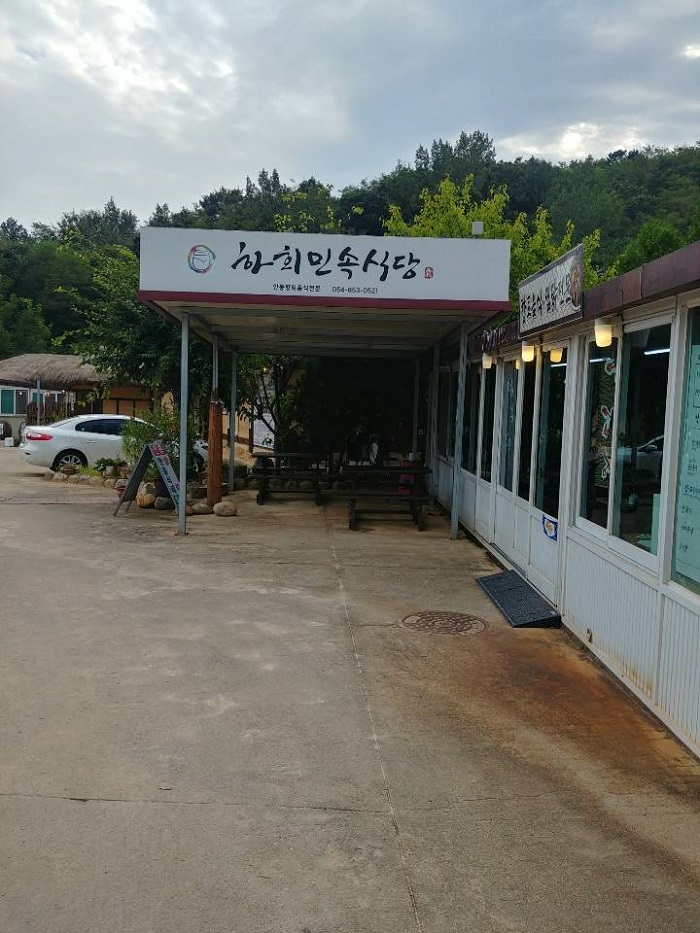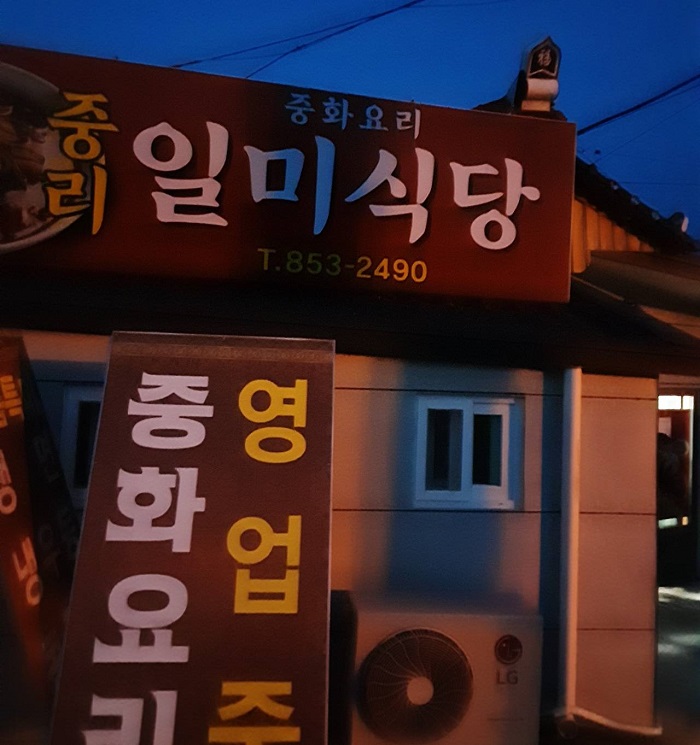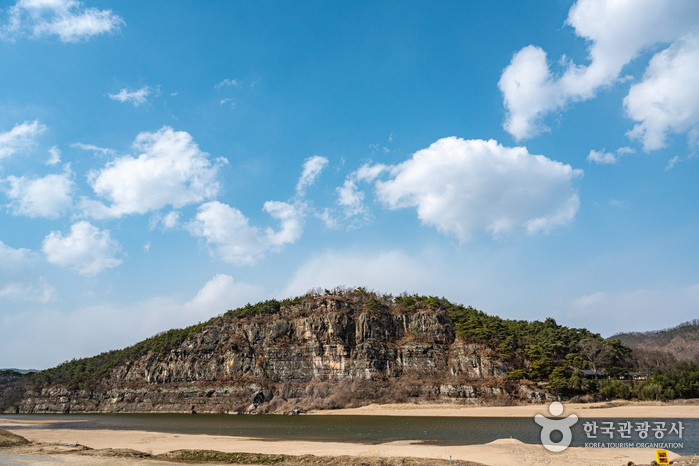Hahoe Minsok Sikdang (하회민속식당)
15.5 Km 32 2021-03-24
214-6, Jeonseo-ro, Andong-si, Gyeongsangbuk-do
+82-54-853-0521
This is a place where you can enjoy Andong steamed chicken and grilled mackerel, the representative foods of Andong. This Korean dishes restaurant is located in Andong-si, Gyeongsangbuk-do. The most famous menu is Andong braised chicken.
Aldea Gunja de Andong (Sitio Arqueológico de Ocheon) (안동 군자마을(오천유적지))
15.5 Km 24398 2024-04-30
Gunjari-gil 29, Waryong-myeon, Andong-si, Gyeongsangbuk-do
La rama Ye-an del fundador del clan Gwangsan Kim, Hyo-ro Kim, creó esta aldea, y desde entonces sus descendientes han vivido aquí. En 1974, cuando se construyó la presa de Andong, la aldea fue transladada desde la zona de Yean-myeon hasta Waryong-myeon, también en Andong, manteniendo su forma original. Entre esos dos puntos, están los puntos culturales del pabellón Takcheongjeong y la residencia Hujodang. En la sala de exhibiciones del pabellón Sungwongak se pueden encontrar extraños archivos que relatan la historia de la familia. Algunos de esos documentos que se exponen son registros familiares, documentos inmobiliarios y registros sobre los sirvientes. Entre esos escritos, hay 7 diferentes que se muestran en 429 piezas.
Pabellón Takcheongjeong
Fue construido en 1541 por el jefe de la rama Ye-an del clan Gwangsan Kim. El pabellón es único y diferente a otros. Permanece como un tesoro y punto cultural muy importante. Durante la dinastía Joseon, el famoso calígrafo Ho Han le puso su nombre actual.
Residencia Hujodang
Esta residencia perteneció al jefe de Ye-an. La fecha exacta de su construcción se desconoce, pero fue realizada por Bupil Kim, quien vivió entre 1516 y 1577. La estructura fue construida separada de la casa principal. Los cuarteles anexos fueron divididos en áreas exteriores e interiores, siendo Hujodang la parte exterior.
Oryuheon House [Korea Quality] / 오류헌 [한국관광 품질인증/Korea Quality]
15.5 Km 5 2023-04-13
18-15, Gireumaje-gil, Andong-si, Gyeongsangbuk-do
Oryuheon House, located near Imhaho Lake in Andong, Gyeongsangbuk-do, offers a chance to stay in a historic house from the Joseon period. The house, also known as Mogwa House, was built by Kim Won-jung, the third son of Sukjong-era rector of the National Academy Kim Bang-geol, when he formed a family of his own in 1678. It was designated as the National Folk Cultural Heritage No. 184. The door’s wooden frame and the open floor space exemplify the beauty of the literati house of the Joseon period, while the sarangchae (men’s quarters) and daemunchae (gate quarters) showcase the sophisticated architecture of the era. Anchae (women’s quarters) retains its original appearance, while the sarangchae was rebuilt in 1920. The construction of the Imha Dam in 1990 resulted in the house’s relocation to its present location.
The owner of the house resides in anchae and sarangchae. Guests have access to a space that includes a 2-kan room, which can accommodate up to 4, an open floor space, and a bathroom. Cooking is prohibited in the house, but guests can make use of a grill located on a small yard reserved for the guests. Korean-style breakfast, including menus like chicken porridge or lotus leaf rice, are offered free of charge in the morning. Nearby sights include the water sports activities in Imhaho Lake, Manhyujeong Pavilion, Hahoe Village, and Dosanseowon Confucian Academy.
Ilmi Sikdang (일미식당)
15.6 Km 24 2021-03-24
1672, Jipung-ro, Andong-si, Gyeongsangbuk-do
+82-54-853-2490
This is a place that is visited frequently by Andong citizens. This Chinese (cuisine) restaurant is located in Andong-si, Gyeongsangbuk-do. The most famous menu is noodles in black bean sauce.
Bosque Recreativo del Monte Hakgasan (학가산자연휴양림)
16.0 Km 43333 2020-10-27
Hyuyangnim-gil 210, Bomun-myeon, Yecheon-gun, Gyeongsangbuk-do
El monte Hakgasan (882 m de altura) en Yecheon, provincia de Gyeongsangbuk-do, está localizado en una remota e intacta región que ha mantenido su belleza natural. Sin embargo, este bosque recreativo es fácilmente accesible tras un relajante paseo por la ribera del río.
Las cabañas de madera que se encuentran en el bosque completan el entorno natural. La refrescante esencia de la madera de los cipreses, junto con las cabañas, hacen que los visitantes se sientan rejuvenecidos. Además, los cálidos rayos del sol entran por las ventanas, dando a las cabañas un hogareño aspecto.
Por encima del bosque se encuentra el hermoso sendero con el que se puede llegar al pico de la montaña en unas 2 horas. Hay también otras instalaciones, como zonas para hogueras, un escenario al aire libre para actuaciones, un parque infantil, un gimnasio, un parque acuático y salas de lectura.
Acantilado Buyongdae (부용대)
16.3 Km 35768 2024-05-07
Gwangdeoksolbat-gil 72, Pungcheon-myeon, Andong-si, Gyeongsangbuk-do
Buyongdae es un acantilado de unos 64 m de altura situado al final de la cordillera Taebaeksan. Desde la cima, se puede obtener una vista panorámica de la Aldea Hahoe de Andong. Su nombre fue tomado de una historia antigua de China y significa "loto". Cerca de este lugar se encuentran los templos Ogyeonjeongsa y Gyeomamjeongsa y la Academia Neoconfuciana Hwacheon Seowon.
Okyeon pavilion [Korea Quality] / 옥연정사 [한국관광 품질인증]
16.3 Km 13101 2023-04-13
86, Gwangdeoksolbat-gil Pungcheon-myeon, Andong-si, Gyeongsangbuk-do
+82-54-854-2202 / +82-10-4520-3640
Ogyeonjeongsa House was established by Ryu Seong-yong (pen-name: Seoae, 1542-1607), a minister of Joseon, with the help of Buddhist monk Tanhong, as a place to study and educate his students. After building Wonjijeongsa House, Ryu wanted to build another house at the foot of Buyongdae Cliff amid a tranquil environment away from the village, but due to his financial situation he was unable to complete the building by himself. Then, the monk Tanhong helped him build Ogyeonjeongsa House, which took ten years (1576 to 1586) to complete, when Ryu was 45 years old. Later, Ryu Seong-yong was able to share warmth with his brother (Gyeomam), who lived in nearby Gyeomamjeongsa House. Ryu later lost his house in Hahoe in the great flood of the Nakdonggang River in 1605, and retired to Ogyeongjeongsa House where he wrote Jingbirok (The Book of Correction, National Treasure 132), a memoir of the Imjin War (Japanese Invasion of Korea in 1592). The house’s guestrooms include Sesimjae (meaning ‘having a mind to this place to achieve at least one in ten thousand things,’ inspired by the I Ching or The Book of Changes), which was used by Ryu as a schoolhouse and has two small rooms between the maru gamheonrok (wooden floor, meaning ‘looking up at the sky and down at the blue water,’ inspired by Wang Xizhi’s poetic diction); Wonlakjae (meaning ‘waiting for a friend’s visit,’ inspired by the Analects of Confucius), in which Ryu himself resided and wrote Jingbirok; and the maru aeoheon (meaning ‘I also love my hut,’ taken from a poem by Chinese poet Tao Yuanming), which measures two kan (a unit of measurement referring to the distance between two columns).
Bukchondeak [Korea Quality] / 하회 북촌댁 [한국관광 품질인증]
16.4 Km 115761 2020-09-08
7, Hahoebukchon-gil, Pungcheon-myeon, Andong-si, Gyeongsangbuk-do
+82-54-853-2110, +82-10-2228-1786
Located in Hahoe-ri (Pungcheon-myeon, Andong-si, Gyeongsangbuk-do), Hahoe Bukchondaek House is a hanok stay that was originally built by a civil official named Ryu Sa-chun in 1797 (the 21st year of the reign of King Jeongjo of the Joseon dynasty). It consists of a small sarangchae (men’s quarters) with two wing buildings at sides. As the anchae (women’s quarters), large sarang, daemungan (gate building), and shrine were built by Ryu’s great-grandson, Ryu Do-seong (who served as a governor of Gyeongsang-do), in 1862 (the 13th year of the reign of King Cheoljong), the house displays the typical features of a Joseon nobleman’s house and is the largest in Hahoe. The large sarangbang, Bukchonyugeo (measuring 7-kan* at the front, 3-kan at the sides), consists of two 2-kan rooms, two 1-kan rooms, a 4-kan daecheong (wooden floor), a 3-kan numaru (upper floor), a 3-kan kitchen, a 3-kan garret, a 5-kan toe (the narrow wooden veranda running along the outside of the building), and a jjokmaru (narrow wooden veranda). The entire building can be converted into a single space simply by opening the sliding doors between the rooms and the doors between the rooms and the daecheong. The medium-sized sarang, Hwagyeongdang, consists of a 2-kan room, a 1-kan daecheong, a 3-kan toe, and a jjokmaru, while the small sarang, Susinwa, consists of a 1-kan room, a 1-kan daecheong, and a 2-kan toe. The anchae has a courtyard in the middle, a kitchen, a main room, a daecheong, a gobang (storeroom), a witsangbang (upper room), a toenmaru (a narrow wooden porch running along the outside of the building), an araetsangbang, a jungmun that links to the large sarang, an araetgwang (storeroom), a dwiju (grain-chest), and a munganbang (gate building room). The munganchae (gate building) and shrine are also situated within the grounds of the house, along with a 300-year-old pine tree that is known for its curved shape, which is said to resemble the Nakdonggang River as it meanders around the village of Hahoe. The house contains valuable cultural heritages including Doseongpaldojido (Map of the Eight Provinces of Korea), which is estimated to date from the seventeenth century, and is regarded as an invaluable historic material as it includes Dokdo Island and Jiandao as part of the Korean territory, and a painting titled ‘Sehwa,’ which is believed to have been given to Ryu Yi-jwa (pen-name: Hakseo, 1763-1837) by the king as a New Year’s present. Bukchondaek House was built by one of the richest families in Hahoe, who are well known for their generosity as they have helped local people on many occasions throughout history. *kan: a unit of measurement referring to the distance between two columns.
RakKoJae Andong(Hahoe) [Korea Quality] / 락고재 안동(하회) [한국관광 품질인증]
16.4 Km 19085 2023-04-13
51, Hahoegangbyeon-gil, Pungcheon-myeon, Andong-si, Gyeongsangbuk-do
+82-54-857-3410
Rakkojae, meaning “a place where one can enjoy ancient traditions and rest one’s soul”, is located near the beautiful ferry on the Nakdonggang River in Hahoe, Andong. After passing by a pine tree decorated with traditional Korean lanterns and entering the cozy courtyard, visitors will find four well-maintained houses with thatched-roofs made with local rice straw. As Rakkojae is some way from the Hahoe Village, and is adjacent to the Nakdonggang River, guests can enjoy walking along the ferry and the walkway while appreciating the beautiful scenery of the river and Buyongdae Cliff with its serene atmosphere. Rakkojae has three guest accommodations – the anchae at the front, the sarangchae and the byeolchae on the sides, and the munganchae. While the anchae has two rooms, a kitchen and a daecheong (main floored room), both the sarangchae and the byeolchae consist of a daecheong and one room. The maximum number of guests per room is ten so that guests can enjoy their stay with ease. Each room is decorated with hanji (traditional Korean paper handmade from mulberry trees) and features a simple built-in closet, ceiling-type air conditioning, and a modern bathroom with a toilet and a bathtub made of Hinoki cypress. In particular, the munganchae has a red clay jjimjilbang (Korean dry sauna) supplied with mugwort that is popular among both domestic and foreign guests. Guests often enjoy relaxing at Rakkojae by appreciating the sunshine and breeze while lying on the daecheong floor, walking barefoot on the earthen ground, and drinking makgeolli (unrefined rice wine)among other activities. The owners of Rakkojae hope that it will be a place where guests can heal their tired body and mind and experience the true atmosphere of Korea. The Pine Wood of Mansongjeong Pavilion (Natural Monument No. 473) situated next to Rakkojae is also a good place for a stroll. Furthermore, the hotel serves a hearty breakfast consisting of heotjesatbap (Andong-style bibimbap with soy sauce) and salted grilled mackerel.
Aldea Hahoe de Andong (안동 하회마을) [Patrimonio Cultural de la Humanidad de la Unesco]
16.4 Km 16674 2024-05-07
Hahoejongga-gil 2-1, Pungcheon-myeon, Andong-si, Gyeongsangbuk-do.
La aldea Hahoe de Andong ha preservado la arquitectura de las casas y la estructura de una aldea tradicional de la dinastía Joseon. Asimismo, hay que destacar que la aldea no fue creada en forma artificial; hay gente que realmente vive allí.
El río Nakdonggang rodea tres de los cuatro flancos de la aldea Hahoe (Material Tradicional de Importancia). La aldea lleva el nombre de Hahoe porque el río forma un remolino alrededor de la misma y también se la conoce con el nombre de Aldea del Río Circular. Al lado de la aldea crecen numerosos pinos y se extiende un llano de suave arena, y frente a este se despliegan bellísimos acantilados. Esta aldea pasó al conocimiento público por una escuela confuciana de la dinastía Joseon (1392-1910), de los maestros Gyeomam (seudónimo de Ryu Un-ryong, 1539-1601) y Seoae (seudónimo de Ryu Seong-ryong, 1542-1607), que realizaron grandes hazañas durante la Guerra de Imjin en 1592.
Gracias a que la aldea está rodeada de las montañas y el río, nunca ha sufrido una invasión. Esta es la razón porque sus casas siguen conservando sus estructuras originales. En la aldea residen 180 familias y son conocidas como el Grupo de la Aldea, pertenecientes a la familia Pungsan Ryu. Dentro de ella, hay casas que fueron designadas Tesoros Nacionales, como por ejemplo Yangjindang y Chunghyodang. Asimismo, hay material importante de tradiciones, como la Casa Hahoe Bukchon, la Casa Hahoe Namchon y Hahoe Juilje. Las casas así designadas calificadas ayudan a preservar el estado original de la aldea de la familia Ryu, especialmente sobre los pilares de referencia de Ryu Un-ryong y Ryu Seong-ryong.
La aldea Hahoe es también famosa por el exorcismo Byeolsingut, la danza de máscara y la Máscara Hahoetal. La Máscara Hahoe-Byeongsantal es la más antigua de Corea y se la usa en la Danza de Máscaras Byeolsingut. La Aldea Hahoe se volvió más popular desde la visita de la Reina Isabel II del Reino Unido en 1999, y durante este tiempo se ejecutaron muchos eventos de Danza de Máscaras.
El Festival Internacional de Danza de Máscaras de Andong tiene lugar entre fin de setiembre y principios de octubre, a lo largo de 10 días aproximadamente, dentro de la Aldea Hahoe y otras áreas designadas.


![Oryuheon House [Korea Quality] / 오류헌 [한국관광 품질인증/Korea Quality]](http://tong.visitkorea.or.kr/cms/resource/29/2706129_image2_1.jpg)


![Okyeon pavilion [Korea Quality] / 옥연정사 [한국관광 품질인증]](http://tong.visitkorea.or.kr/cms/resource/50/2578050_image2_1.jpg)
![Bukchondeak [Korea Quality] / 하회 북촌댁 [한국관광 품질인증]](http://tong.visitkorea.or.kr/cms/resource/74/2626274_image2_1.jpg)
![RakKoJae Andong(Hahoe) [Korea Quality] / 락고재 안동(하회) [한국관광 품질인증]](http://tong.visitkorea.or.kr/cms/resource/84/2573784_image2_1.jpg)
 Español
Español
 한국어
한국어 English
English 日本語
日本語 中文(简体)
中文(简体) Deutsch
Deutsch Français
Français Русский
Русский